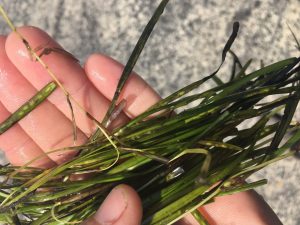
Facebook Twitter Instagram YouTube RSS Feed
Written on: November 27th, 2018 in Wetland Restorations
By Michael Bott, DNREC Watershed Assessment and Management Section
Have you ever wondered why there is so much submerged aquatic vegetation (SAV), also called seagrass, in the tidal waters of Virginia and Maryland but not in Delaware? This is a question many researchers and regulators in the state have been trying to solve and this year has finally given those involved some hope.
Unlike the Chesapeake Bay, the Delaware Bay is a very different ecological system and the naturally turbid waters do not support these large seagrass beds. Delaware’s Inland Bays on the other hand are similar to the Chesapeake and Coastal Bays of Maryland and Virginia and recently there have been some encouraging developments that someday this important ecosystem can flourish in Delaware.
In the Chesapeake Bay, ongoing largescale projects aim to restore and protect large seagrass meadows but historically Delaware’s restoration efforts have been small in comparison.
Just like wetlands provide countless services by purifying water, providing essential habitat and reducing storm impacts; SAV provides many of these same ecosystem benefits to the underwater world. Don’t forget, open water is a wetland too!
Seagrass beds help to stabilize sediments, provide essential nursery habitat to aquatic species and improve recreational fishing and hunting opportunities in the waters where they grow.
As we continue to reduce nutrients such as Nitrogen and Phosphorus from entering our waterways, we should see less of the bad species of algae which covers the bottom blocking sunlight, thus creating more available habitat for SAV.

Eelgrass seeds collected in the spring of 2018 used in the restoration of the state’s last known eelgrass bed in the Inland Bays.
When people talk about SAV, the first thing many think of are the iconic eelgrass beds of the lower Chesapeake and Coastal Bays of Maryland and Virginia, but not Delaware. Indian River Bay is home to the only known eelgrass bed in the state. This small bed has been clinging to life for over 15 years, but has been unable to expand its range much on its own.
Over the years, restoration efforts have tried to start small eelgrass beds in other portions of the Inland Bays, but so far these efforts have failed. Instead of trying to do the same exact thing and hoping for different results, the restoration efforts this year focused on trying to increase the size and health of the existing eelgrass bed. The hope is that if the current bed can grow, it will be able to produce enough seeds that could be transported by tides or wind to nearby areas to start new beds.
In the higher salinity marine waters where eelgrass grows you can also find widgeon grass, an equally important species that can be found from coastal bays to roadside ditches. In the lagoons and canals of South Bethany, this species has slowly been taking a foothold in the Inland Bays. It has been known for several years that widgeon grass could be found in these canals at low densities, often near the dead ends and away from boat traffic.
In 2018 the widgeon grass beds exploded which was very exciting for those researchers and regulators mentioned above, but was not viewed with the same enthusiasm by residents who now were dealing with SAV clogging their boat motors instead of algae. This event provided an opportunity for all parties to work together to help educate those who thought this was just another nuisance algae. It was also a great opportunity to use the seed resource to try and establish an SAV bed in nearby Little Assawoman Bay.
If you want to help SAV return to the coastal waters of the State of Delaware, you can do your part in many of the same ways you help protect the more familiar wetlands you see every day. By maintaining healthy wetlands, harmful nutrients and other pollutants are removed before they enter the coastal waters and negatively impact seagrass beds.
It is also important to be mindful when boating in areas where SAV are found because a boat prop can quickly destroy all the hard work put into restoration. Currently a proposed regulation, if adopted, will prohibit clamming in SAV beds which are mapped by the state.
There are also groups working to protect SAV beds in freshwater tidal rivers of the state like the Nanticoke Watershed Alliance, where species such as wild celery and other freshwater vegetation can be found. By joining or supporting your local non-profit environmental organizations such as the Delaware Center for the Inland Bays, the Partnership for the Delaware Estuary or the Nanticoke Watershed Alliance, you can actively show your support for SAV and make sure your voice is heard.